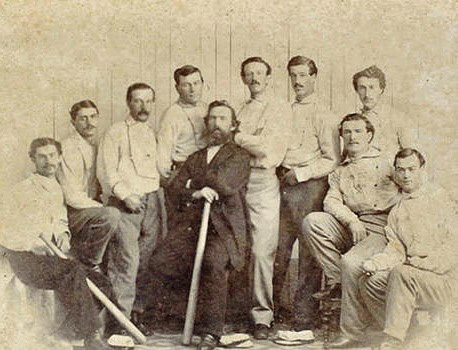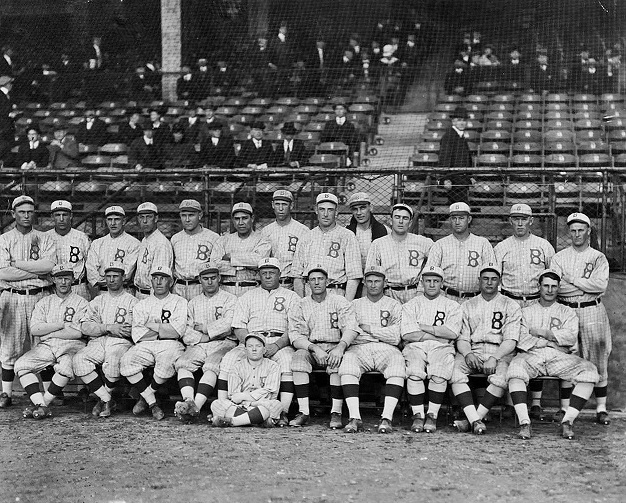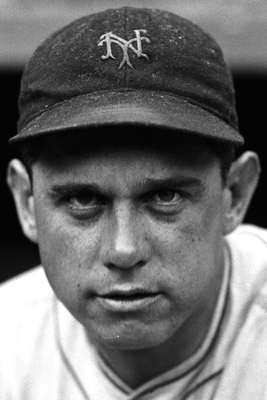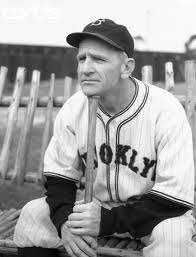I hate the Giants. I have always hated the Giants.
Why?
Because I’m a Dodger fan and they’re the Giants – it’s as simple as that.
And while the players, coaches and managers today may claim that the intense rivalry between the two franchises is only a fan thing, the truth of the matter is that the Dodgers hate the Giants and the Giants hate the Dodgers – always have, always will.
But how did this rivalry begin? Or perhaps a better question is when did it begin? Here again, a simple answer – pretty much when baseball began. As for the how, here is the long and short of it:
In 1849, an amateur baseball club called the Atlantics was formed in the city of Brooklyn, New York. The Atlantics competed against the Excelsior, Putnam and Eckford clubs from across the eastern part of the country. So popular was this game of baseball becoming (especially in Brooklyn) that these four amateur clubs created what was called the National Organization of Baseball Players in 1857.
The Brooklyn Atlantics proved to be a very good club and were recognized as the national champions in 1864 and 1866. But perhaps their greatest accomplishment occurred in 1870 when they beat the Cincinnati Red Stockings in an exhibition game. The Red Stockings were the first professional team in baseball history, having begun “play for pay” a year earlier in 1869. The Red Stockings were unbeaten in 65 games as they toured the East and Midwest competing against amateur clubs. They would, of course, later become the Cincinnati Reds.
As fan support grew and with the help of a man named George Taylor, who was the city editor of the New York Herald, the Atlantics were able to get financial support from the city of Brooklyn and joined the newly formed American Association as a professional team in 1883 – thus, the Brooklyn Dodgers were born (although they wouldn’t be called that for several more years).
Also in 1883, John B. Day and Jim Mutrie, who owned the American Association’s New York Metropolitans (which was managed by Mutrie), decided to form a new National League team called the New York Gothams. On May 1, 1883, the Gothams played their first game at a field once used for polo matches at 110th Street and Sixth Avenue. The Gothams would go on to finish in sixth place with a 46-50 record in their inaugural season.
In 1885, Mutrie left the Metropolitans (or the Mets, as they were more commonly called) to manage the Gothams and on June 3, 1885 after an exciting extra-inning win over Philadelphia, Mutrie was so overcome with emotion that he reportedly blurted out a one-word description of his team that immediately became the franchise’s new nickname. That word, of course, was “Giants!” The rechristened Giants finished second in the National League, while the Mets slumped to seventh place in the American Association.
Prior to the 1886 season, Day and Mutrie sold the Mets to Erastus Wiman who moved the team to the St. George Cricket Grounds on Staten Island in hopes of promoting ferry trade across New York harbor. This business plan failed and the Mets ceased operation following the 1887 season. The failed team was purchased by the Brooklyn Atlantics to gain territorial protection and to acquire the contracts of several of the Mets’ star players.
In 1888 the city of New York evicted the Giants from the original Polo Grounds, forcing them to play two games at Oakland Park in New Jersey and 23 games back at the St. George Cricket Grounds before finally moving to yet another Polo Grounds located at 155th Street and Eighth Avenue, where they would remain for the next 69 years. In spite of the disruptions, the Giants finished the 1888 season with an 83-43 record – one game ahead of the Boston Beaneaters for the NL pennant. The Giants would go on to beat the pennant winners of the American Association in a Championship Series that would eventually be called the World Series. Who was that American Association team? The Brooklyn Atlantics, of course – thus, one of baseball’s greatest rivalries was born.
In 1890 the Atlantics changed their name to the Brooklyn Bridegrooms, a moniker given them because several of their players had recently wed and the team moved over to the National League. The Bridegrooms enjoyed immediate success by winning the NL pennant. A postseason series was played against the Louisville club, who were the pennant winners from the American Association; however, the series was hampered by poor weather and long travel and ended in a tie.
On New Year’s Day 1898 New York City was born and the city of Brooklyn became one of its five boroughs. But in spite of this move, many Brooklynites still saw two things as belonging solely to them – the Brooklyn Bridge and their beloved Brooklyn Bridegrooms.
In 1899 the Bridegrooms changed their name to the Brooklyn Superbas and won the NL pennant. They followed that up by winning it again in 1900 to become the first team to win the NL pennant in the 20th century. Unfortunately, they would not win another until 1916. In between, the Superbas would become the Trolley Dodgers, the Dodgers and the Robins.
After a 16-year drought, the Robins finally won the NL pennant with record of 94-60 record to earn a trip to their first-ever World Series. After dropping Game 1 to the Boston Red Sox at home, the Robins scored a run in the first inning of Game 2, but failed to score again in a 14-inning pitchers duel against a 21-year-old left-hander by the name of George Herman “Babe” Ruth, who eventually won the game to give the Red Sox a 2-0 series lead. The Robins would bounce back to take Game 3 in Boston, but the Red Sox would take the next 2 games and won the series 4 games to 1.
While all of this was happening, across the bridge and under the leadership of eventual Hall of Fame manager John McGraw, the Giants dominated the National League. In fact, between 1883 and 1957, the Giants won 14 pennants, 4 NL championships (the predecessor to the World Series) and 5 World Series titles. On the other hand, the Dodgers (finally named as such for good in 1932) won 9 pennants (six of which were between 1947 and 1956), 3 NL Championships, and only one World Series title in 1955.
Yet in spite of their dismal history, the Dodgers had the most loyal fans in all of baseball and frequently led the league in attendance. And while such loyalty didn’t necessarily help the Dodgers, it most definitely hurt the Giants. Perhaps the best example of this occurred in 1934.
Prior to the start of the 1934 season, second-year Giants manager Bill Terry was being interviewed by a group of reporters. He was asked by several of them how he thought the Phillies, Cardinal, Pirates, Cubs, Braves and Reds would do during the upcoming season and Terry shared his opinions on each. When he was asked how he thought the Brooklyn Dodgers would do, Terry, who was trying to be funny, replied “Is Brooklyn still in the league?” Needless to say, every reporter in the room laughed – but they also quoted Terry verbatim in their respective newspapers. When word of this reached Brooklyn, it sent Dodger fans into an absolute frenzy.
Even though the Dodgers had yet another dismal season and were hopelessly sitting in 6th place with only two games remaining, those two games were to be played at Polo Grounds against the their archrival Giants, who were tied with the St. Louis Cardinals for first place. Never before had Bill Terry wished he had never made his Brooklyn comment than on the Saturday prior to the first game of the series. Thousands of Dodger fans made the trip to the Polo Grounds and immediately started in on Terry with “Is Brooklyn still in the league? You’ll find out today, you bum! You’ll win the pennant, will you? You louse. We’ll fix you today, you (expletive).”
While all of this was going on in the bleachers, there was another message being delivered – this one in the Dodgers clubhouse by manager Casey Stengel. “Parmelee is going to pitch for them. …You know he can be wild. Wait him out. Make him give you your ball to hit. All right let’s go. We’re still in the league.”
The Dodgers indeed waited Parmelee out which forced him to make good pitches – and they hit him hard, beating the Giants 5-1. In the meantime, the Cardinals won their game against the Reds in St. Louis, thus putting the Giants in a must-win situation for the remaining game to force a playoff for the pennant. Sunday’s crowd was every bit as loud as Saturday’s had been and in spite of his efforts to remain unseen, Terry continued to hear it from Dodger fans. When it was over and the dust had settled, the Dodgers had beaten the Giants 8-5 to knock them out of the World Series. In his seven remaining years as the Giants manager, Bill Terry never again asked if the Dodgers were still in the league.
Since that fateful series in 1934, there have been numerous times that either the Dodgers have knocked the Giants out of contention or vice versa – none bigger than Bobby Thompson’s “Shot heard ’round the world” off of Ralph Branca to win the NL pennant in 1951 and Steve Finley’s walk-off grand slam off of Wayne Franklin to win the NL West title in 2004.
So the next time you hear a player, coach or manager say that the rivalry is only a fan thing, the appropriate response is “Yeah, right.”
Source: The Brooklyn Dodgers – An Informal History by Frank Graham – G.P. Putnam’s Sons – 1945 / SportsEcyclopedia.com
(Re-posted from January 31, 2013)




 December 13th, 2015 at 6:00 am
December 13th, 2015 at 6:00 am  by Ron Cervenka
by Ron Cervenka 



 Posted in
Posted in 

Yes, the rivalry was going on before we were born. I entered the picture as a Giant hater when Thomson hit that home run to win the ’51 pennant but somehow and I know most Dodger fans will agree, I feel like I was around in those early days, in the 1930s and before.
Somehow, Joe, I think you missed the point.
I realize it was about the teams hating each other but I doubt it was as much as the fans.